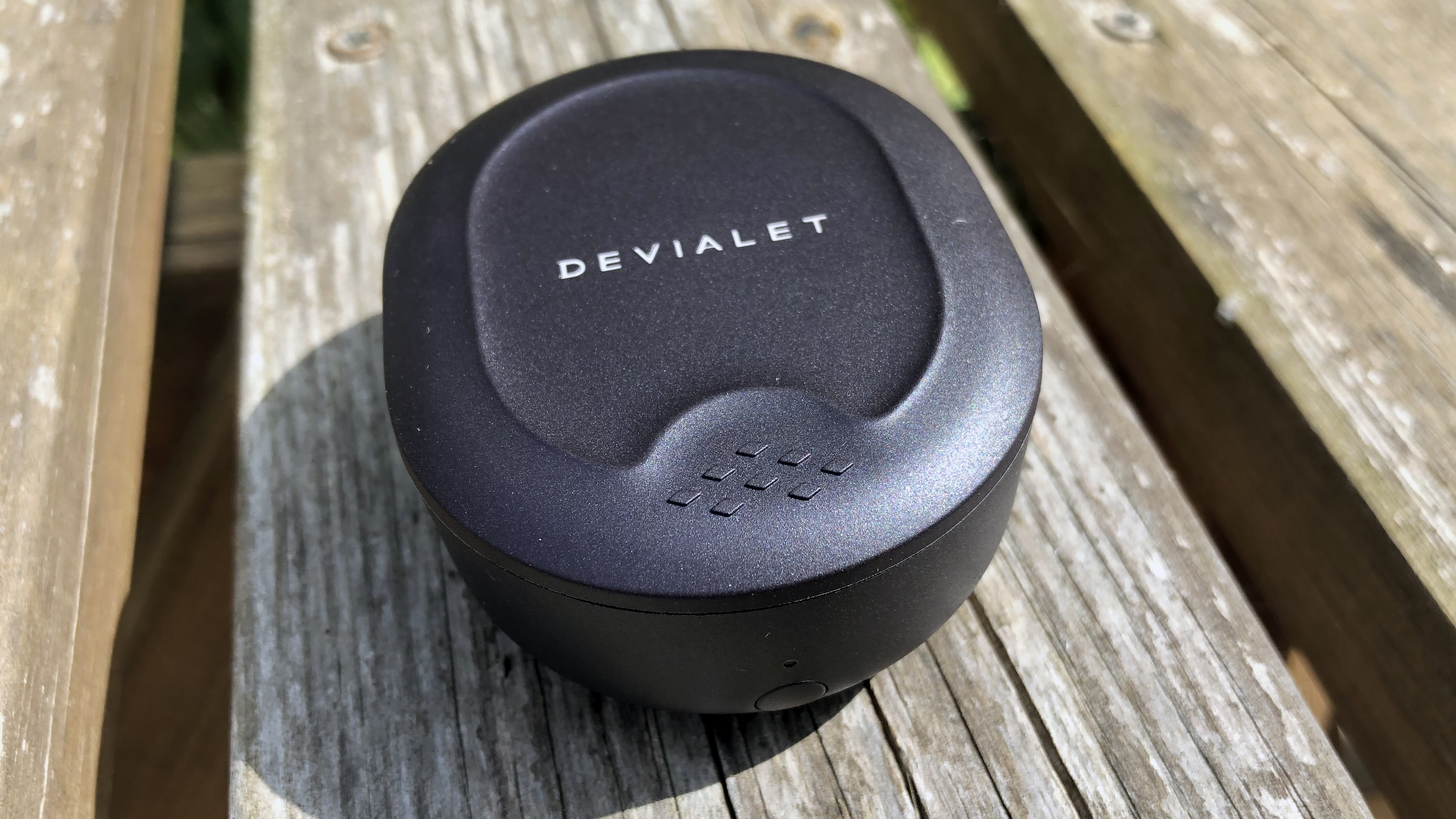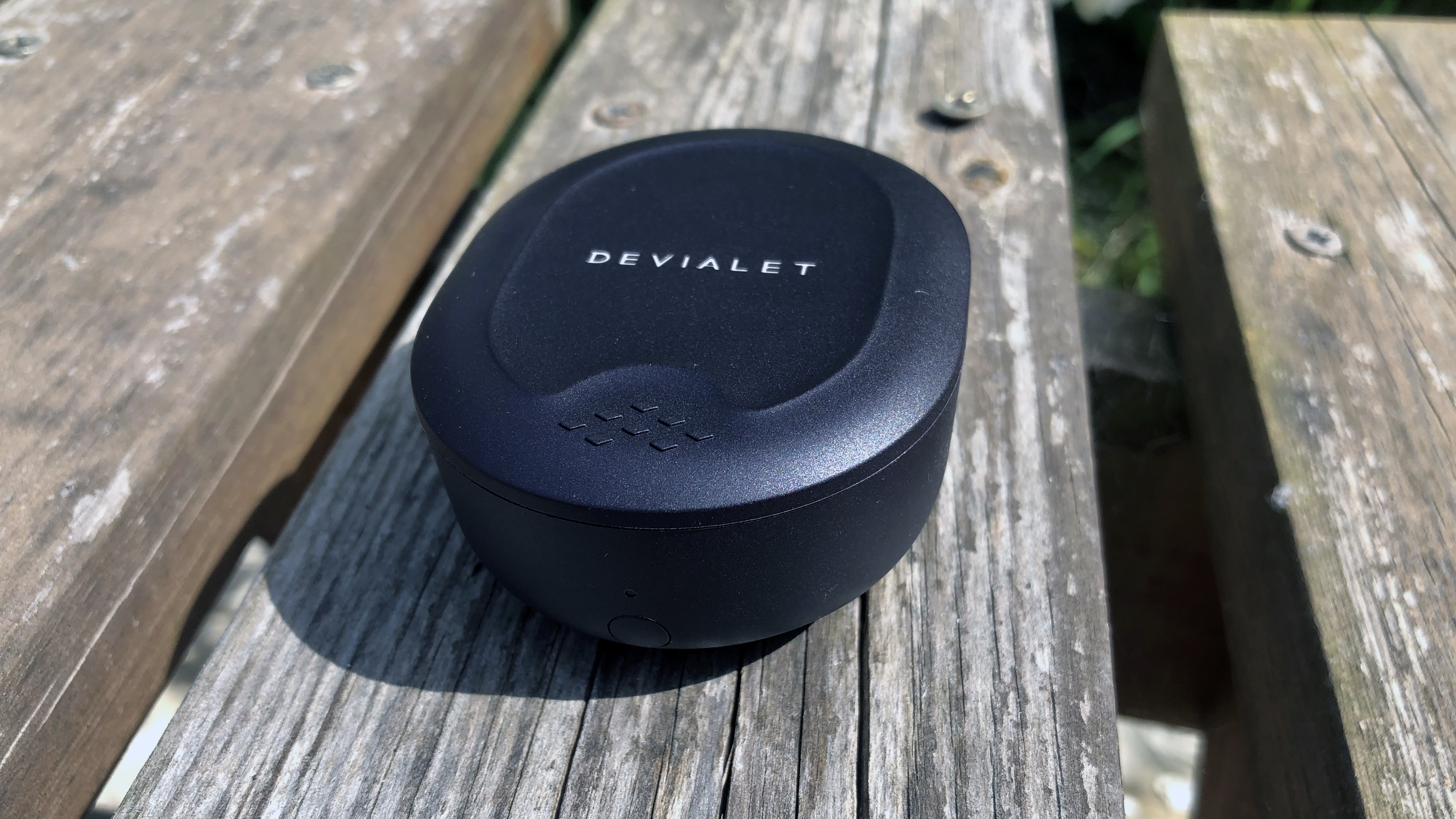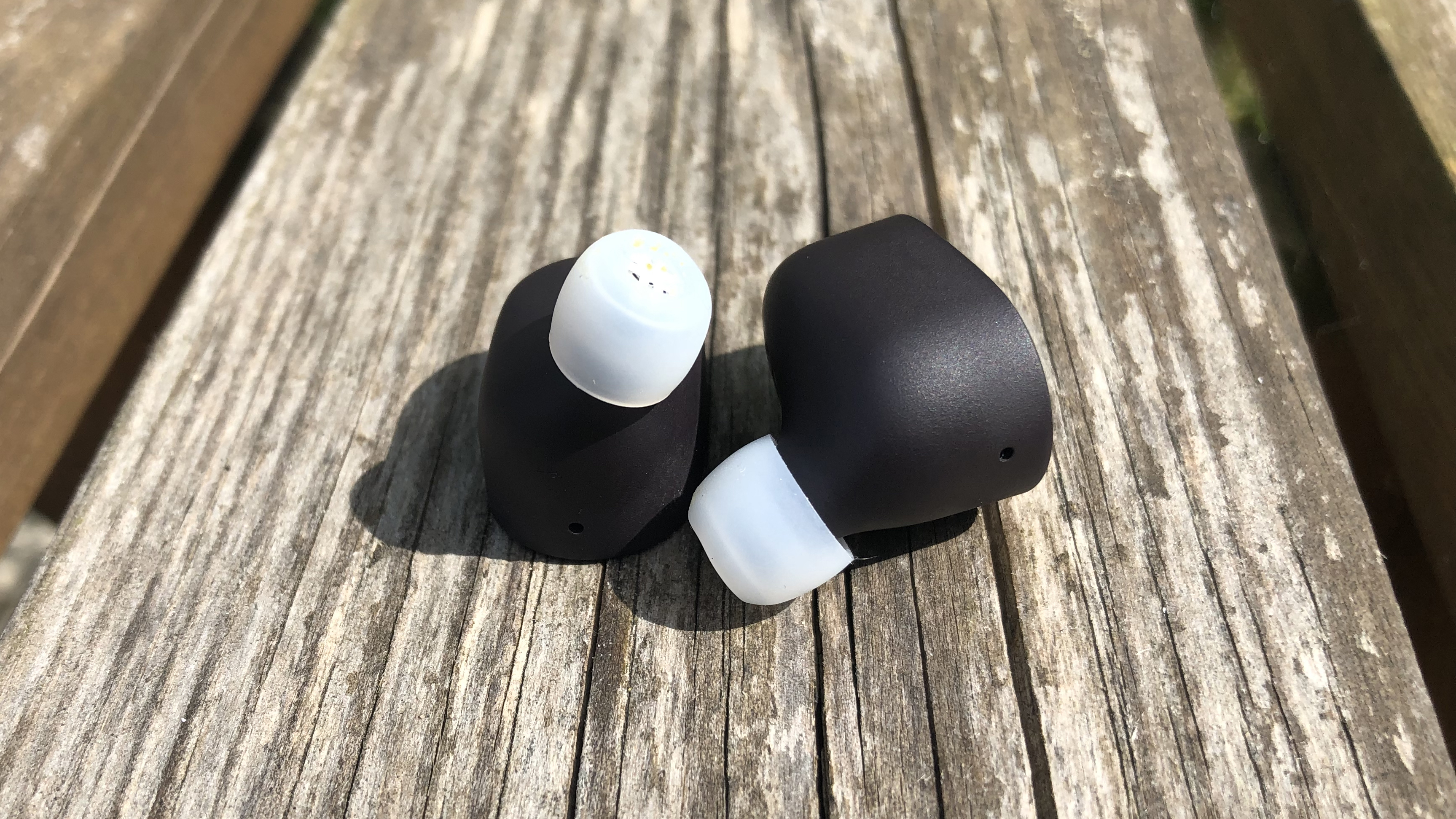TechRadar Verdict
With the Gemini active noise-cancelling true wireless in-ear headphones, Devialet gets more right than it gets wrong. Mind you, when it goes wrong it really goes wrong. These true wireless earbuds offer a long battery life and sound great – but once you turn the active noise cancellation off, that excellent audio performance is all but lost.
Pros
- +
Can sound poised and informative
- +
Nice charging case (which holds plenty of power)
- +
Some interesting technologies
Cons
- -
Performance with ANC switched off is poor
- -
Sound isn’t very expansive
- -
Touch controls could be better
Why you can trust TechRadar
One-minute review
Devialet’s first active noise-cancelling true wireless earbuds aren’t going to give the market leaders any sleepless nights – but that’s not to say they’re charmless. If you enjoy taking the road less travelled, you might find them to be just the ticket.
Build quality and finish are well up to par. No, there’s no room here for any of Devialet’s signature design flourishes, but the Gemini manage to look reasonably distinctive nevertheless. Battery life is competitive – it’s certainly superior to Sony’s new (and all-conquering) WF-1000XM4. And while the control app doesn’t do enough, and the touch controls don’t do what you want with any consistency, the Devialet have plenty going for them when it comes to sound. They’re a rapid, well organized, clean and punchy listen.
That’s always assuming you’ve left active noise-cancelling switched on, though. As noise-cancelling circuitry goes, it’s pretty effective – but more importantly, if you switch it off the sound of the Gemini goes sideways. And not in a good way.
Just how oddball do you like your active noise-cancelling true wireless in-ear headphones? That’s the real question.

Devialet Gemini price and availability
- Available now for $299 / £279 (about AU$390)
The Devialet Gemini active noise-cancelling true wireless earbuds are on sale now for $299 / £279. That works out at around AU$390, with Australian pricing still to be confirmed.
That’s pretty much on par with other true wireless in-ears from specialist brands (such as Bose, Grado, Sony or Sennheiser) are concerned. We’re not used to Devialet products being so competitively priced… Its recent Phantom I speaker costs $3,200 / £2,790 / AU$5,490, for example.

Design
- aptX Bluetooth
- Rather restricted control app
- Good battery life
The problem with a small product like this for a company like Devialet is how little scope there is for luxurious design. If you look at the Devialet’s previous products, it’s always gone to town just as much with looks and finish as with performance. But true wireless in-ear headphones just don’t lend themselves to this sort of indulgence. They’re a deeply functional item.
And though you can almost hear the company gritting its teeth, Devialet has done the sensible thing and delivered a pair of true wireless earbuds that are utterly functional. Oh, they look nice and they feel good, but apart from the stylized ‘D’ on each capacitive touch-surface, there’s nothing here to indicate they’re the product of a company with an abiding reputation for design flair. So deep is Devialet’s need to display just a little of its individuality, it’s fitted the Gemini charging case with an unusual sliding lid.
And there’s equally little opportunity for Devialet to indulge itself where specification is concerned. It’s managed to cram in a few original technologies (which we’ll discuss shortly), but broadly speaking, you’re getting exactly what you’d expect from a pair of wireless earbuds.
The Gemini feature Bluetooth 5 wireless connectivity, with support for AAC, aptX and SBC codecs. The earbuds themselves hold six hours-worth of power (which isn’t bad) and the charging case holds another four full charges (which is pretty good) so an all-in total of 30 hours between visits to a power outlet is achievable. When it comes to it, charging is via the case’s USB-C input or on any Qi-certified charging pad.

The earbuds themselves are supplied with four different sizes of silicone eartip, and at 6g and 15 x 18 x 33mm each, they’re quite compact and comfortable. The case itself, at 58 x 74 x 31mm and 74g, isn’t too big to slip inside a pocket.
On the inside, the earbuds feature a bespoke – and big (10mm, in fact) – full-range transducer, with a claimed frequency response of 5Hz to 20kHz.
The Gemini can be controlled using the Devialet Gemini control app, using Google Assistant or Siri voice control, or via the capacitive touch-surface on each earbud. There are feed-forward and feed-back mics in each earbud, and where voice assistance is concerned, they prove perceptive and responsive.
This is in rather stark contrast to the touch-controls, which are more of the ‘hit and miss’ variety. You can assign their function using the app – ‘play/pause’, ‘skip forwards/backwards’, ‘answer/end/reject call’ and ‘noise-cancelling on/off/transparency’ are all included, while the app will let you ditch ‘skip forwards/backwards’ in favor of ‘summon voice assistant’. You’ll notice that ‘volume up/down’ is not an option, and it’s an annoying omission that makes you fish your music player out of your pocket in order to change volume level.
The app also lets you select the level of noise-cancellation – choose between ‘low’, ‘high’ and ‘plane’ – or switch it off altogether. You can also fiddle with the degree of ‘transparency’ (‘low’ or ‘high’), switch ‘auto-pause’ on or off, check for software updates and adjust left/right balance.

As already mentioned, though, Devialet is going to take the opportunity to go full Devialet if it can – and with the Gemini, that opportunity arises where active noise-cancellation is concerned. The company has deployed three important-sounding technologies in an effort to reduce external noise intrusion by (it claims) 40dB – they’re Internal Delay Compensation, Pressure Balance Architecture and Ear Active Matching.
IDM is an algorithm that intends to cancel noise in the especially problematic upper end of the frequency range. PBA is a physical series of vents that allow static air trapped by the earbud to escape the wearer’s ear canal. Finally, EAM measures acoustic leakage caused by the position of the earbud in the wearer’s ear and adjusts equalization to compensate.

Audio performance
- Clean, vibrant sound...
- ...as long as you don’t switch off active noise-cancelling
- Slightly hemmed-in presentation
aptX Bluetooth is more than good enough for getting some nice high-resolution audio files on board the Devialet, so why not? With an MQA-powered Tidal Masters file of Sons of Kemet’s Pick Up Your Burning Cross on board, some things the Gemini can do is pretty impressive. Some, though, aren’t quite so impressive.
The ‘positives’ column is probably a bit longer, so it seems the fairest place to start. This is a pretty hectic, multi-layered recording apparently performed by musicians who are all actively competing with each other – but the Gemini show real control and resolution. They describe the ‘start’ and ‘stop’ of individual notes with proper confidence, and manage to give each musician a bit of room on what’s a fairly crowded and all-action stage. Despite allowing each element of the recording its own area, though, the Devialet still manage to serve up a sense of unforced integration. It’s all the more impressive when you consider the Gemini don’t describe the largest soundstage by any means.
The top of the frequency range has more than enough bite and attack to make the percussive sounds (as well as the willful honks and squawks of brass instruments) sound substantial and purposeful, but there’s a pleasant lack of hardness or grittiness to these treble sounds. At the opposite end, bass is deep and textured, with no overhang and nice straight edges into and out of notes and hits. In between, the midrange is equally detailed, equally well organized and every bit as convincing.
The same tune allows the Gemini to showcase quite impressive dynamic potency, both where the ‘quiet/loud/louder still’ aspects are concerned and with the more nuanced harmonic dynamics that jazz recordings tend to be awash with. They’re proficient with rhythms, too, and when a recording becomes spare and quiet they take unwanted sounds out of the equation.

Noise cancellation
- Three settings to choose from
- Turning off ANC negatively impacts sound
- Transparency mode
There’s not a massive amount of difference between the three settings of active noise-cancellation – but no matter which one you’ve selected, external sounds are minimized. Like every other pair of active noise-cancelling true wireless headphones, though, the Devialet must bow to the mighty Bose QuietComfort Earbuds where noise-cancellation is concerned.
Switch the noise-cancellation circuitry off, though (it’s indicated as ‘neutral’ in the app) and the entire story changes – we can honestly say we’ve never heard the sonic characteristics of a product alter so fundamentally simply by changing one of its settings.
With noise-cancellation on, the Gemini are robust – with it off, they become bony and insubstantial. It’s almost as if all the EQ levels have been changed at once, and it transforms the Devialet from being quite an enjoyable listen to something much less engaging.
And while we’re bemoaning the effect of circuitry on the sound, ‘transparency’ is altogether too keen to get involved too. Leave it off and all is well – set it to ‘low’ and the midrange hogs the stage; set it to ‘high’ and bass gains a whole load of undeserved confidence. Mind you, at least ‘transparency’ does increase the amount of external sound you can hear.
Should I buy the Devialet Gemini?

Buy them if...
Individualism matters to you
These earbuds will stand out in a crowd of Apple AirPods lookalikes.
You enjoy clean, vivid sound
Leave the settings well alone and the Gemini are capable of really engaging sound.
You like to try proprietary tech
EAM. IDM. PBA. You don’t get this sort of thing with Bose.
Don't buy them if...
You sometimes want to disable active noise-cancellation
Honestly, it’s a recipe for sonic disaster.
Touch-control is your favorite
The Gemini touch-controls are far from the most responsive or reliable.
You like wide-open sound
The Gemini presentation is easy to follow, but it all happens on a rather restricted stage.
- Looking for more? Check out the best noise-cancelling earbuds you can buy
Simon Lucas is a senior editorial professional with deep experience of print/digital publishing and the consumer electronics landscape. Based in Brighton, Simon worked at TechRadar's sister site What HiFi? for a number of years, as both a features editor and a digital editor, before embarking on a career in freelance consultancy, content creation, and journalism for some of the biggest brands and publications in the world.
With enormous expertise in all things home entertainment, Simon reviews everything from turntables to soundbars for TechRadar, and also likes to dip his toes into longform features and buying guides. His bylines include GQ, The Guardian, Hi-Fi+, Metro, The Observer, Pocket Lint, Shortlist, Stuff T3, Tom's Guide, Trusted Reviews, and more.

